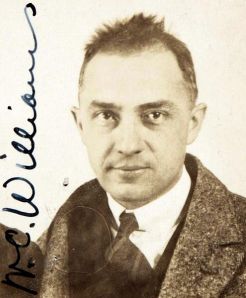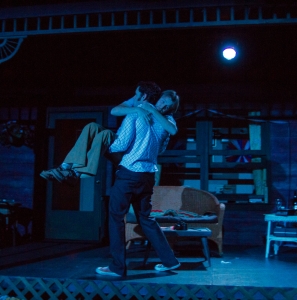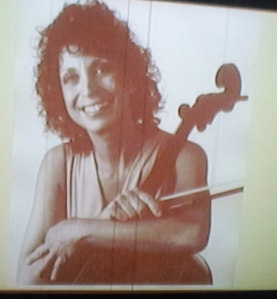
The Flying Dutchman by Albert Pinkham Ryder (c. 1896)
Here’s a piece I wrote for San Francisco Opera’s new production of The Flying Dutchman – a look into Wagner’s attraction to the source material he used for his breakthrough opera:
“…[T]he faithful woman hurls herself into the sea and the curse on the Flying Dutchman is lifted, he is redeemed, and we see the ghostly ship sinking to the bottom of the sea. The moral of this piece, for women, is that they should beware of marrying a Flying Dutchman; and we men should draw from it the lesson that women, at best, will be our undoing.”
It might not be unreasonable to assume this quotation comes from a critic hostile to Wagner. Or perhaps it represents a merry ribbing of the unintended absurdities that never seem far from the surface in his operas, a la Anna Russell? (“The scene opens in the River Rhine. IN it.”) Yet this sardonic wink at the climactic scene of The Flying Dutchman is actually taken from the chief source Wagner used for the opera in which, as consensus has it, he began to realize his authentic voice for the first time.

Richard Wagner: drawing by Julius Ernst Benedikt Kietz, 1840-1842
That source is “The Fable of the Flying Dutchman,” an episode contained within the longer unfinished novel Aus den Memoiren des Herren von Schabelewopski (From the Memoirs of Herr von Schnabelewopski), which was published in late 1833— eight years before Wagner composed the bulk of his opera. Its author is the great German–Jewish writer Heinrich Heine (1797–1856), and his narrator recounts this story as the plot of a play he has witnessed; his retelling of what he sees onstage moreover embeds an erotically titillating episode involving a seductive fellow audience member (her sexually loose behavior making her a kind of anti-Senta).

Heinrich Heine: portrait by Moritz Daniel Oppenheim
Heine here applies his celebrated genius for irony to the tale of the wretched mariner whose defiant pride has doomed him to sail forever on a phantom ship. (In both Heine and Wagner, “the Flying Dutchman” refers not to the protagonist, who is unnamed, but to his doomed ship.) Heine’s bathetic parody of Romantic pathos was so effective precisely on account of the popularity of this relatively modern variant of an ageless legend (a principle that can still be seen operating in the success of films like the Pirates of the Caribbean franchise). The meme of the Cursed Sailor and his crew likely took shape as European empires expanded their maritime trade activities. While it had made the leap from oral folk tale to literature only recently, the culture was already saturated with this meme when Heine added his cynical depiction of “Mrs. Flying Dutchman”—already by 1826 the London playwright Edward Fitzball could score a hit with a partially farcical, over-the-top melodramatic treatment of this material.
Everyone loves a good ghost story, of course, and Shakespeare and Stephen King alike know how to captivate their audiences with a chilling yarn that can simultaneously provide entrée into something more profound. But the Dutchman motif proved especially alluring in the emerging era of Romanticism. From poets such as Samuel Taylor Coleridge (The Rime of the Ancient Mariner) and Thomas Moore to popular German storytellers of the early nineteenth century, it quickly made a trans-Atlantic crossing and became a theme frequently encountered in American letters. Examples include the writings of Washington Irving, James Fenimore Cooper, and Edgar Allan Poe (both the short story “MS. Found in a Bottle” and The Narrative of Arthur Gordon Pym introduce Poe’s own fascinating twists on this material).

The Flying Dutchman, published in Collier’s Weekly, December 8, 1900 (oil on canvas),
by Howard Pyle (1853–1911)
The Dutchman’s eerie fate gratified a craving for tales of supernatural crime and punishment that also found expression in the work of several of Wagner’s predecessors: most notably, the German Romantic operas of Carl Maria von Weber and Heinrich Marschner (who composed one on a faddish vampire story) and Giacomo Meyerbeer’s early French grand opera Robert le Diable.
Nor was Wagner without precedent in recognizing in his cursed protagonist a resonant metaphor for deeper existential questions. The Gothic sense of alienation from ordinary society that is key to Wagner’s portrayal of the Dutchman taps into related currents of darker Romantic angst about modernity—as seen, for example, in Lord Byron’s world-weary anti-hero Manfred and Mary Wollstonecraft Shelley’s precocious novel Frankenstein, or, The Modern Prometheus. In addition, as Dieter Borchmeyer remarks in Drama and the World of Richard Wagner, the Dutchman of lore can be viewed as “a symbol of the hubristic spirit of discovery that transgressed the boundaries of knowledge and experience” dictated by religion” and “is thus the maritime equivalent of Faust.”

Frontispiece to Frankenstein by Mary Shelley (revised edition from 1831 of the novel first published in 1818)
It’s not by coincidence that during his exile in Paris, Wagner abandoned work on a Goethe-inspired Faust Symphony not long before embarking on The Flying Dutchman. (He later published what he had completed as an independent concert overture.) The composer himself analyzed this move toward “the specificity of the drama” as a liberation “from the mists of instrumental music.”
Wagner’s intense attraction to the Dutchman legend can hardly be explained as an attempt to exploit a topic made fashionable by popular culture. In fact, hot on the heels of his first commercial success with Rienzi, the more artistically adventurous Flying Dutchman initially earned a lukewarm reception (there were only four performances of the original Dresden production).
Another angle from which to consider the tale’s grip on the composer’s imagination, according to Joachim Köhler’s controversial biography Richard Wagner: The Last of the Titans, is arguably an inner need to exorcize “the traumatic experiences of horror and the fear of ghosts that kept him awake at night”—terrors that in Köhler’s portrayal had been imprinted on him as a sensitive child. And in a fascinating essay on The Flying Dutchman in the context of the operatic genres of its time, Wagner expert Thomas Grey writes that the composer turned the “melodramatic” claptrap associated with the story—“with its mysterious portraits, invisible voices, ersatz folk ballads, and sentimental ‘romances’”—into “an allegory of Romantic alienation, love, and redemption.” In doing so, “Wagner was aiming to rehabilitate this ailing branch [the “homely genre” of German Romantic opera] of his artistic patrimony.”

Last scene from the Dresden premiere production: Leipziger Illustrierte Zeitung, 3 January 1843
Yet what drew Wagner so compulsively to the satirical version of the legend set forth by the notoriously anti-Romantic Heine, whose ironic posture he simply stripped away? Heine, in fact, exercised a far-ranging influence on Wagner’s future career. The aspiring young artist had been befriended by the poet, a fellow exile in Paris who welcomed him into his circle (and quite possibly even helped Wagner polish his French prose in the scenario he prepared for submission to the Paris Opera). Köhler points out that “virtually all the mythological themes that were to be associated with Wagner’s name were already touched on” in Heine’s writings (such as the Grail legends, the tale of Tristan and Isolde, the riding Valkyries, and Tannhäuser’s excursion into the forbidden Venusberg). And in his earlier autobiographical accounts, Wagner credited Heine for giving him “all I needed to adapt the [Dutchman] legend and use it as an operatic subject”—though Wagner’s metastasizing anti-Semitism likely underlay his later suppression of any reference to his debt to Heine.
“One must be able to joke about the most sublime of things,” declared Wagner (as reported by his wife Cosima in her diaries). Borchmeyer adds that “as early as 1840 [before he had even completed his Dutchman libretto] he had written French parodies of Senta’s Ballad and the Sailors’ Chorus, showing how tragic themes immediately evoked parodic associations in his imagination.” (When you get down to it, “The Ride of the Valkyries” is not such a great distance from vaudeville.) By way of making sense of Wagner’s transformation of the satirical source he discovered in Heine into a primal existential drama, Borchmeyer suggests that “the subject has reacquired its former tragic seriousness, having lived through the experience of its own comic negation…which explains why, in turn, Wagner’s music dramas have repeatedly invited writers to parody them.”
— (c)Thomas May. All rights reserved.
Filed under: opera, Wagner




















